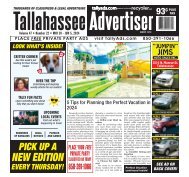TT_021519_AllPages
You also want an ePaper? Increase the reach of your titles
YUMPU automatically turns print PDFs into web optimized ePapers that Google loves.
THETRUCKER.COM<br />
b Letters from page 10 b<br />
involved deaths recently and calling again for<br />
speed limiters on heavy-duty trucks.<br />
Make the cars who always pull over to the<br />
side of the highway to take their dog to go pee or<br />
do that themselves with their flashers on, go to an<br />
on-ramp instead.<br />
[It’s] common sense. We have to move to the<br />
other lane when these idiots pull over on the side<br />
of the highway for stupid reasons. Cars are almost<br />
always the cause of semi [involved] crashes.<br />
No one wants to take someone’s life, so we<br />
do what we have to, to avoid that so we don’t<br />
have to live our life out knowing we killed<br />
someone.<br />
The authorities do nothing to keep cars<br />
from cutting us off or tailgating us or brakecheck<br />
us. The dash cam is the most valuable<br />
thing we can use.<br />
But yet, we are always at fault.<br />
— Judy Ochs<br />
The accidents are caused by these commercial<br />
truck companies, not by the [truck] drivers<br />
or speed of the trucks.<br />
These companies hide behind the ELD<br />
[with] forced dispatch and abusive treatment of<br />
drivers. These companies have a very high rate<br />
of driver turnover.<br />
The dispatched pick-up and delivery times<br />
are always off and short, such as having about<br />
one hour left to drive and dispatched for a pickup<br />
90 miles away in heavy traffic, and the driver<br />
is fired if he or she doesn’t make it.<br />
The trucking companies looking for drivers<br />
on The Trucker are part of the commercial<br />
companies that are the bad guys, here.<br />
Remember, we honor our drivers and get<br />
our drivers home, NOT, when they allow you<br />
home time after being hired.<br />
— Jeffrey B. Duggar<br />
I’ve noticed that people who want these<br />
[speed] limiters are people who’ve never driven<br />
a truck. How many people at the American<br />
Trucking Associations have driven a truck and<br />
yet they know what’s best for drivers.<br />
They say people want speed limiters on big<br />
trucks, that’s because they’re only getting one<br />
side of the whole story.<br />
— Tony Jenkins<br />
I feel that more distracted cell phone drivers<br />
and “choker chained” drivers on ELDs are<br />
stressed out to drive harder. That would be the<br />
main reason for the uptake in crashes [rather]<br />
than increased speeds.<br />
As a governed driver for 25 years, I know<br />
what a disaster driving bunched up would be<br />
— especially if ALL trucks were limited (example<br />
NASCAR Talladaga “big one” crashes).<br />
As to trucks needing more room to stop, yes<br />
they do but any experienced driver knows this<br />
and maintains the appropriate safe following<br />
distance.<br />
Also, heavier vehicles have corresponding<br />
larger braking capacity-disc brakes and tighter<br />
stopping distance regulations have been a<br />
move in a positive direction.<br />
— James Stark 8<br />
Perspective February 15-28, 2019 • 11<br />
b Eye from page 10 b<br />
• Wearing a Bluetooth earpiece or headset<br />
with mic<br />
• Wearing headphones or ear buds<br />
• Manipulating in-vehicle systems (touching<br />
radio, climate control, touchscreen display or other<br />
controls (excludes operating stalks or buttons<br />
on the steering wheel)<br />
• Manipulating or holding mobile electronic<br />
devices other than cellphones<br />
• Talking or singing<br />
• Eating or drinking<br />
• Smoking<br />
• Grooming<br />
• Other (reaching for object, reading print<br />
material, adjusting sun visor, putting on<br />
glasses, holding another object).<br />
“When people talk about distracted driving,<br />
most often cellphones are the focus, but drivers<br />
are distracted by other secondary behaviors more<br />
often than cellphones,” Kidd said. “Things as<br />
simple as drinking coffee or talking to your kids<br />
can take your attention away from the road.”<br />
About 14 percent of drivers were engaged<br />
in nonphone-related secondary behaviors in<br />
2014 and 2018, which exceeded the proportion<br />
of drivers seen using phones in both years.<br />
Relative to 2014, drivers were more likely<br />
to be observed manipulating an in-vehicle system,<br />
grooming themselves, or manipulating or<br />
holding an electronic device other than a phone<br />
after researchers adjusted for community, perceived<br />
driver gender and age, time of day and<br />
roadway situation.<br />
Drivers in 2018 were less likely to be talking<br />
or singing while driving alone, smoking,<br />
or wearing headphones or earbuds. The prevalence<br />
of eating or drinking, talking or singing<br />
with a passenger present, wearing a Bluetooth<br />
device, or engaging in some other visible secondary<br />
behavior wasn’t significantly different<br />
between 2014 and 2018.<br />
“We didn’t find evidence of an increase in<br />
distracted driving overall between the 2014<br />
and 2018 roadside surveys,” Kidd says. “For<br />
cellphone-related distraction in general, we expect<br />
a continued shift in the way people interact<br />
with the devices as the technology evolves.”<br />
The percentage of crash deaths related to<br />
distraction in recent years has hovered at about<br />
8–10 percent of all crash deaths, data from the<br />
National Highway Traffic Safety Administration<br />
show. During the past three years, distraction-affected<br />
crash deaths have trended downward.<br />
The number of fatalities in distractionaffected<br />
crashes fell 9.3 percent from 3,490 in<br />
2016 to 3,166 in 2017, representing 8.5 percent<br />
of total fatalities for the year. In 2015, 3,526<br />
people were killed in distraction-related crashes.<br />
The IIHS said fatality data likely underestimate<br />
the number of deaths caused by distracted<br />
drivers.<br />
Despite efforts to determine cellphone use<br />
by drivers in crashes, such data continue to be<br />
difficult to collect as they largely depend on<br />
people truthfully telling law enforcement officers<br />
what they were doing or voluntarily handing<br />
over their phones for inspection, the IIHS<br />
said.<br />
Bottom line: Fiddle only to make music. 8

















